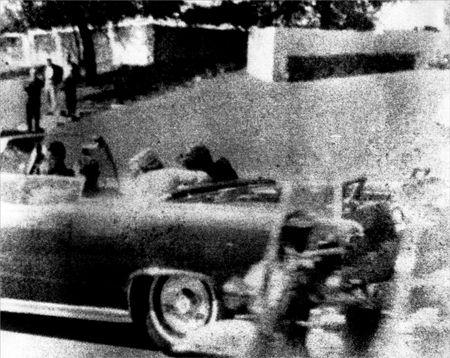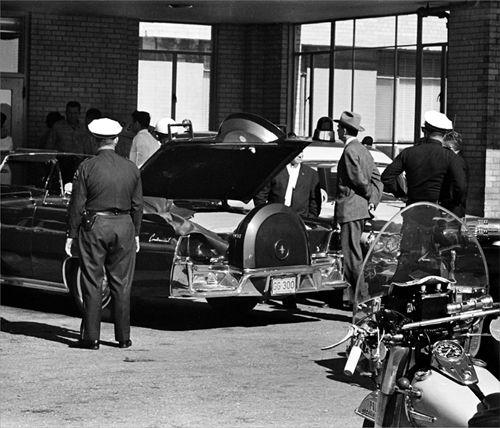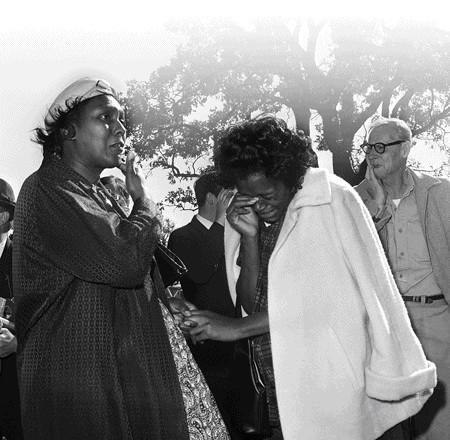Read Kennedy's Last Days: The Assassination That Defined a Generation Online
Authors: Bill O'Reilly
Kennedy's Last Days: The Assassination That Defined a Generation (26 page)

Secret Service special agent Clint Hill hears the shots and leaps into action. Shoving himself away from the running board on Halfback, the vehicle directly behind the president’s limousine, Hill sprints forward in an effort to jump on the small step that sticks out from the back of the president’s car.
Meanwhile, JFK is leaning to his left, but still upright. Jackie wraps her hands lovingly around her husband’s face.
Jackie’s arms are still wrapped around her husband when the front of his head explodes. Brains, blood, and bone fragments shower the first lady’s face and clothes. The matter sprays as far forward as the limousine’s windshield visors.
The man who swam miles to save the men of
PT-109
, who has shaken the hands of kings and queens and prime ministers, who inspired the entire world with his bold speeches and deeply held belief in the power of democracy and freedom, who caressed the cheeks of his children, who endured the loss of loved ones, and who stood toe-to-toe with men who might otherwise have destroyed the world, is brain dead.

Jackie leans toward JFK. This photograph was taken by a witness, Mary Moorman, a fraction of a second after the first shot.
[© Corbis]
CHAPTER THIRTY-SIX
NOVEMBER 22, 1963
Dallas, Texas 12:31
P.M.
I
NSIDE THE PRESIDENTIAL LIMOUSINE,
there is chaos.
“Oh, no, no, no. Oh, my God. They have shot my husband. I love you, Jack,” Jackie Kennedy cries.
Up front, driver Bill Greer and Special Agent Roy Kellerman are radioing that the president has been hit. Bill Greer speeds toward nearby Parkland Hospital with the accelerator all the way to the floor.

The presidential limousine with its trunk open parked at the emergency entrance at Parkland Hospital.
[Tom Dillard/Dallas Morning News/Corbis]
The president’s body falls over and onto Jackie’s lap. She holds his head in her white-gloved hands, cradling him as if he has simply fallen asleep. “Jack, Jack. What have they done to you?”
* * *
The radio call of “Code 3” means an emergency of the highest importance to Dallas-area hospitals. The term is almost never used. So when Parkland dispatcher Anne Ferguson requests more details, she is simply told, “The president has been shot.”
The time is 12:33
P.M.
Three minutes later, the presidential limousine roars into Parkland, blowing past the sign reading
EMERGENCY CASES ONLY.
Bill Greer parks in the middle of the three ambulance bays.
But there is no stretcher waiting, no emergency team waiting to help the president. Incredibly, there has been a breakdown in communications. The trauma team has just been notified.
Jackie Kennedy refuses to let go of her husband. The first lady curls her body forward around the president’s blood-soaked face.
“Mrs. Kennedy,” Special Agent Clint Hill says, “please let us help the president.”
Jackie doesn’t respond.

A crowd gathers at Parkland Hospital, anxiously waiting for news of the president’s condition.
[© Bettmann/Corbis]
Hill realizes something. It’s bad enough that she is seeing the man she loves with his head blown apart, but she doesn’t want anyone else seeing him like that. There is no way in the world Jackie will allow John Fitzgerald Kennedy to be photographed in this state.
Knowing in an instant that it is the right thing to do, Special Agent Hill removes his suit coat and sets it gently atop the president’s body. Jackie Kennedy wraps her husband’s head and shoulders in Clint Hill’s coat.
The president is placed on a gurney and hustled into the hospital and down the corridor to Trauma Room One.
An overhead fluorescent lamp lights the small army of medical professionals at work. A tube is inserted into John Kennedy’s throat to open his airway, and to replace fluids, saline solution is pumped into his body through a vein in his thigh.
The room slowly fills with surgeons, until there are 14 doctors standing over the president. Outside the trauma room, Jackie rises from her chair, determined to enter. She has heard the talk about fluids and resuscitation and is beginning to hope that her husband just might live. A nurse blocks her path, but the gracious first lady can display an iron will when she wants to. “I’m going to get into that room,” she repeats.
The first lady stands in a corner, out of the way, just wanting to be near her husband. Finally, Dr. William Kemp Clark, Parkland’s chief neurosurgeon, knows they can do no more. A sheet is drawn over JFK’s face. Dr. Clark turns to Jackie Kennedy. “Your husband has sustained a fatal wound,” the veteran surgeon tells the first lady.
“I know,” she replies.
“The president is dead.”
Jackie leans up and presses her cheek to that of Dr. Clark. It is an expression of thanks. Dr. Clark, a hard man who served in the Pacific in World War II, can’t help himself. He breaks down and sobs.

People burst into tears when hearing of Kennedy's death.
[© Associated Press]
CHAPTER THIRTY-SEVEN
NOVEMBER 22, 1963
Dallas, Texas 1
P.M.
V
ICE
P
RESIDENT
L
YNDON
J
OHNSON
is under constant watch from the instant his motorcade limousine arrives at Parkland Hospital. He is hustled into a small white cubicle in Parkland’s Minor Medicine section with his wife, Lady Bird. A Secret Service detail guards his life. A patient and a nurse are kicked out to make room for them. The Secret Service wants LBJ flown immediately back to Washington and out of harm’s way. Failing that, it would like him relocated to the safest possible security zone in Dallas:
Air Force One
.
But Vice President Johnson refuses to leave the hospital. He remains, waiting for word of President Kennedy’s fate. The Secret Service pressures him again and again to depart, but LBJ will not go.
Shortly after 1:00
P.M.
, Kenny O’Donnell marches into the cubicle and stands before Lyndon Johnson. O’Donnell is openly distraught. He is not the sort of man who weeps at calamity, but the devastated look on his face is clear for all to see.
Even before O’Donnell opens his mouth, LBJ knows that it is official: Lyndon Baines Johnson is now the 36th president of the United States.
* * *
Bobby Kennedy gets the bad news from J. Edgar Hoover.

LBJ leaving Parkland Hospital after President Kennedy’s death. His Secret Service agent, Rufus Youngblood, is in front of him and Representative Homer Thornberry from Texas follows.
[© Bettmann/Corbis]
As the head of America’s top law enforcement agency, Hoover is informed of the shooting almost immediately. The FBI director is a reserved man, but never more so than right now. He sits at his desk on the fifth floor of the Justice Department Building and picks up the phone to call Bobby Kennedy. It has been 15 minutes since Lee Harvey Oswald first pulled the trigger. The surgical trauma team at Parkland is fighting to keep the president alive.
Bobby is just about to eat a tuna fish sandwich on the patio of his Virginia home when his wife, Ethel, tells him he has a call.
“It’s J. Edgar Hoover,” she tells Bobby.
The attorney general knows this must be important. Hoover knows better than to call Bobby at home. He sets down his sandwich and goes to the phone. It’s a special direct government line known as Extension 163.
“I have news for you,” Hoover says. “The president has been shot.”
Bobby hangs up. His first reaction is one of great distress, and his body seems to go slack. He answers phone call after phone call from friends and family. He holds back tears, but Ethel knows that her husband is breaking down and hands him a pair of dark glasses to hide his red-rimmed eyes.
* * *
Most people in the United States get the bad news from CBS newsman Walter Cronkite. He is called “the most trusted man in America” because of his simple, straightforward way of explaining world events.
Cronkite first breaks into the soap opera
As the World Turns
just eight minutes after the shooting, saying that an assassin has fired three shots at the president. Despite the fact that most Americans are at work or school, and not home watching daytime television, more than 75 million people are aware of the shooting by 2:00
P.M.

